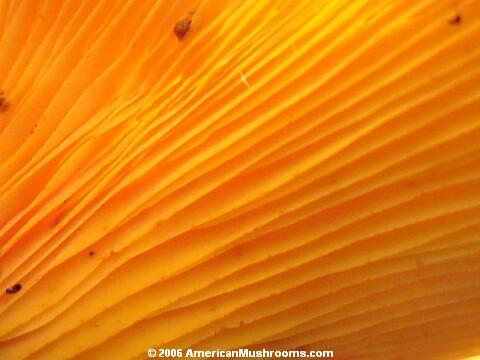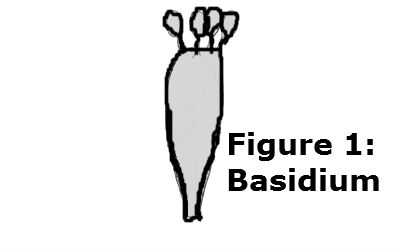Classification
Domain: Eukarya
This classification is assigned to organisms whose cells are enclosed within membranes. This shows the separation of Eukaryotic and Prokaryotic organisms. Prokaryotic organisms include bacteria and archaea. When translated, Eukarya means, “true nucleus”. This information is useful to detect whether or not an organism is a Eukaryote. Since the Jack O’Lantern Mushroom has a true nucleus and a membrane.
Super-Group: Opisthokonta
Organisms assigned to this group are ones that possess a rear flagella. A flagella is a threadlike appendage that allows for locomotion. It looks almost like a tail that moves to propel an organism through an aqueous environment. In humans, rear flagella are found on sperm. There has been much debate as to this defining characteristic when relating it to fungi. Chytridiomycota, a fungi phyla, has flagellated spores for example, but Basidiomycota do not. Some hypothesize that the rear flagella on fungi was lost throughout evolution, while other are skeptical if it was ever present at all.
Kingdom: Fungi
The name fungi is given to heterotrophs that feed by absorption. To learn more about what this means, visit my Interactions page. Another characteristic that separates fungi from other species is that they have a cell wall composed of chitin. Chitin is a substance that is produced by the organism and used most commonly as a method of protection. Some insects, like spiders, have a chitinous exoskeleton to protect their bodies. Chitin was first discovered in fungi and is even used in everyday materials like nail polish and toothpaste. So remember to thank fungi for allowing chitin to be discovered next time you are painting your nails or brushing those pearly whites!
Phylum: Basidiomycota
This name is given to Fungi whose spores are borne externally on a structure called a basidium. To learn more and see what a basidium looks like, visit my Life/Reproduction page. Another interesting Basidiomycota is Psilocybe cubensis. Unlike the Jack O’Lantern Mushroom, P.cubensis is hallucinogenic. The closest genetically related Phylum is the Ascomycota. As seen in recent studies, the protein sequence of these two are identical. The extreme similarity of their genetic makeup is supporting evidence that they are derived from a common ancestor. (Antelo et al. 2009) In contrast to Basidiomycota’s spores, the Ascomycota’s spores are borne internally on a structure called an ascus. An interesting Ascomycete is Aspergillus fumigatus.
Class: Agaricomycetes:
This fungi is separated into this class based on the shape of its basidium, called a homobasidim. The structure is club shaped and bears sexual spores, usually in multiples of four. In contrast to the club shaped structure of the homobasidium, the tremelloid basidia has a structure which appears to be more fork-like. The illustration to the right depicts this idea.
Order: Agaricales
The presence of gills is the defining
characteristic for this classification. While the mind may
immediately wander to the structure of a fish gill, mushroom
gills are much different and nonrelated to that of a fish.
Mushroom gills are thin “plate-like” structures on the
underside of the mushroom that are lined with basi dia. Gills
are sometimes copied by other mushrooms that do not possess
true gills. These can be differentiated by the fact that
true gills are not forked or split in any region. View the
image to the left to see this concept.
dia. Gills
are sometimes copied by other mushrooms that do not possess
true gills. These can be differentiated by the fact that
true gills are not forked or split in any region. View the
image to the left to see this concept.
Family: Marasmiaceae
Fungi at the family level are primarily categorized based on their spore color. Marasmiaceae is a family for fungi that are known to possess spores that are white in color. In comparison, Psilocybe cubensis is a fungus that possesses a brown spore.
Genus: Omphalotus
This is a name given to Fungi with a depressed disc in the cap of the mushroom. This simply means that the top of the mushroom caves in at the center. The depression of the cap is not known to do much for the mushrooms lifestyle. Perhaps the purpose of the different shape is simply natures attempt to create visual diversity. Physical characteristics help organisms like humans categorize and differentiate. From the shape of a mushroom cap to the color of a snake, we use visual cues that nature gives us for everyday tasks; like being able to tell something poisonous from something that is not.
This refers to the Jack O’Lantern mushroom that grows to the east of The Rocky Mountains, some parts of Europe, and in some parts of Southern California. The name olearius is translated to the Latin word olea meaning olives. While olives and mushrooms may seem unrelated, this translation is significant because this mushroom is found growing at the base of Olive Trees. Click here to learn about Olive Trees.


